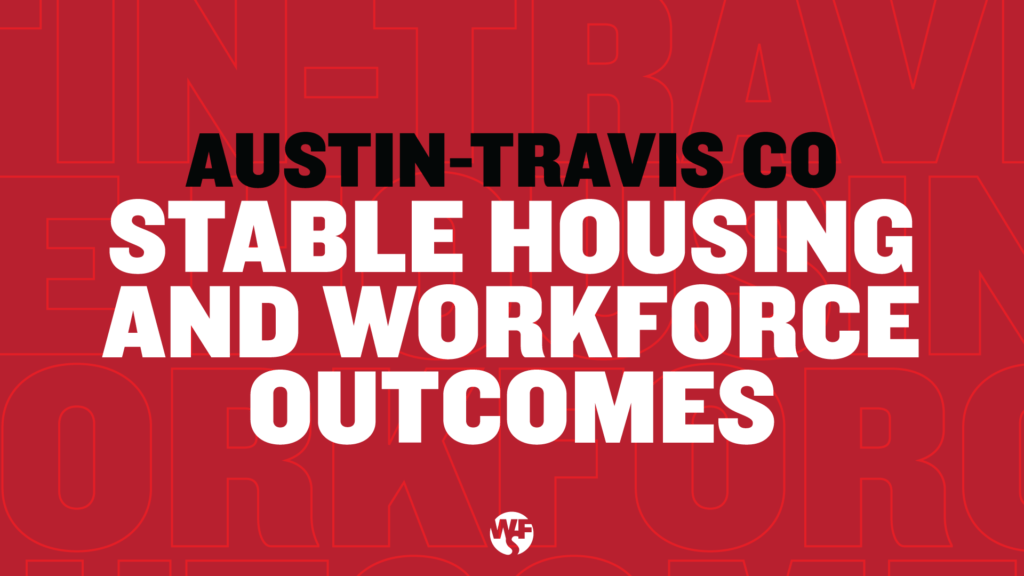3-minute read
In this edition: In a new WFS report, research suggests the outcomes of stable housing efforts can be improved when combined with workforce development efforts.
Good news: Comparing April against pre-pandemic February 2020, Austin’s 1.5% deficit in jobs puts the metro at No. 2 for recovering job losses among major U.S. metros, behind only Salt Lake City.
- Where other Texas metros rank: San Antonio and Dallas are also in the top 10, while Fort Worth (-3.1%) ranks No. 11 and Houston (-5.4%) ranks No. 28.
- If we compare job growth in the 12 months between April 2020 to April 2021, Austin is at No. 8.
🎙️ “Being able to continue to grow even amidst a pandemic is a testament to Austin’s spirit of innovation and entrepreneurship. We look forward to welcoming even more of the region’s vast talent pool to Rev as we ‘rev up’ for growth.” — Revup.com Inc. CEO Jason Chicola on their plans for Austin expansion. Read more.
Were you forwarded this email? Sign up to receive my weekly updates here.
In partnership, Tamara.

1 big thing | WFS Report: Stable Housing and Workforce Outcomes
A new WFS report offers curated research and trends on stable housing and workforce outcomes.
Why it matters: To support a more equitable and affordable Austin-Travis County, WFS is uniquely positioned to assist low-income and unsheltered residents and students during the entire transition from program to career.
- WFS programs increase the number of working-class people by preparing unskilled residents for higher-paying careers and supporting unsheltered residents who are striving for hope and stability through new skills and work.
- WFS serves homeless individuals at a historic rate with a high pre-COVID employment rate for this population. We served 631 homeless individuals from June 2018 – July 2019 through all of our services. That’s 10% of our total customers served.
The big picture: Research suggests the outcomes of stable housing efforts can be improved when combined with workforce development efforts. Through workforce services,individuals and parents experiencing homelessness or housing insecurity can have greater success in job training and employment.
Here are five takeaways from the report…
1. Housing insecurity is an important source of employment insecurity among low-income workers.
- A 2016 Harvard study shows housing loss substantially increases the likelihood of job loss. Researchers propose that eviction temporarily diminishes the ability of many low-wage workers to perform at their jobs.
- In addition, housing insecurity has risen in relative lockstep with employment insecurity. In the private rental market, where most low-income families live, affordable housing has shrunk dramatically. While monthly rent increases, the number of families receiving federal subsidies plummeted.
- Today, only 25% of households that qualify for housing assistance benefit from it. As a result of these changes, rent burden among low-income households has surged. In 2013, the majority of poor renting families spent at least half of their income on housing costs, with almost a quarter dedicating over 70% to it.
2. Stable housing may be an important prerequisite to parent success in job training and employment.
- Welfare-to-work programs that help parents find jobs are more effective among families that receive housing assistance than among other families.
- When researchers compared families that were randomly selected to receive vouchers to families in a control group who did not use them, they found that vouchers reduced the share of families that lived in shelters or on the streets by three-fourths, from 13% to 3%;
3. Stable housing can strengthen parenting and support early childhood development.
- Housing vouchers for families in poverty have many benefits, particularly for children. Research from the 2013 Family Options Study on homeless families who received housing vouchers shows that vouchers decrease economic stress and food insecurity, help keep families together (and keep kids out of the child welfare system), reduce the rates of domestic violence and alcohol dependence, and limit school changes among children.
- Further compiled research from the Urban Institute shows that: too many households do not have stable housing; housing plays a critical role in providing stability to poor families, and when families lack it, there are terrible consequences; and stable housing can strengthen parenting and support early childhood development.
4. Many families receiving housing assistance will not move to a better area unless they receive support.
- Living in certain neighborhoods seems to expand opportunity, but families need assistance to first move to them.
- In a March 2020 study, economist Raj Chetty and a team of researchers partnered with the Seattle housing authority to put a twist on the housing voucher system.
- The experiment found that the additional support raised the share of families moving to high-opportunity neighborhoods from 14% to 54%.
5. Expanding access to Housing First with Intensive Case Management appears to be warranted from an economic point of view.
- In the At Home/Chez Soi trial for homeless individuals, from October 2009 through July 2011, 1,198 individuals were randomized to the intervention (Housing First intervention with Intensive Case Management) or treatment as usual and followed up for as long as 24 months.
- Participants in the intervention group received recovery-oriented supports from an intensive case management team, which proved to be cost-effective compared with treatment as usual.

